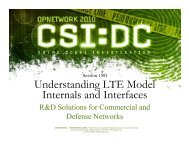Automated Axon Tracking of 3D Confocal Laser Scanning ...
Automated Axon Tracking of 3D Confocal Laser Scanning ...
Automated Axon Tracking of 3D Confocal Laser Scanning ...
You also want an ePaper? Increase the reach of your titles
YUMPU automatically turns print PDFs into web optimized ePapers that Google loves.
Track the centerlines in the MIP image as far as possible, (2) switch to cross-sectional tracking ifan axon cross-over is detected and (3) switch back to MIP tracking once the cross-over isresolved. We propose a guided region merging algorithm which is efficient in segmenting theaxons when their boundaries are blurred due to imaging artifacts. Both shape and intensityinformation is used to track the axons which help us segment the axons in the cross-sectionalplane accurately.The organization <strong>of</strong> the paper is as follows. The method for extracting axon centerlines intwo dimensions is mentioned in Section 2.1. In Section 2.2, we describe the approach adopted tosolve the cross-over problem by switching to the cross-section based approach. Section 2.3introduces our guided region growing algorithm which uses a probabilistic method based on thefeatures extracted from the previous cross-sections.We conclude the paper by demonstrating the results <strong>of</strong> this algorithm in Section 3. Ouralgorithm is applied on three datasets, and the results are compared with the manual results. Todemonstrate the efficiency <strong>of</strong> our algorithm, its performance is compared with the centerlineextraction method using repulsive snake model (Cai et al., 2006).2. Materials and MethodsMaterialsThe raw data available for analysis consists <strong>of</strong> stacks <strong>of</strong> cross-sectional images <strong>of</strong> the axonsobtained from neonatal mice using laser scanning confocal microscopes (Olympus FlouviewFV500 and Bio-Rad 1024) equipped with motorized stage. For our study, the neurons <strong>of</strong> interestall expressed cytoplasmic YFP relatively uniformly inside each cell. YFP was excited with a448nm line <strong>of</strong> argon laser using an X63 (1.4NA) oil objective with a 520-550nm band-pass6















